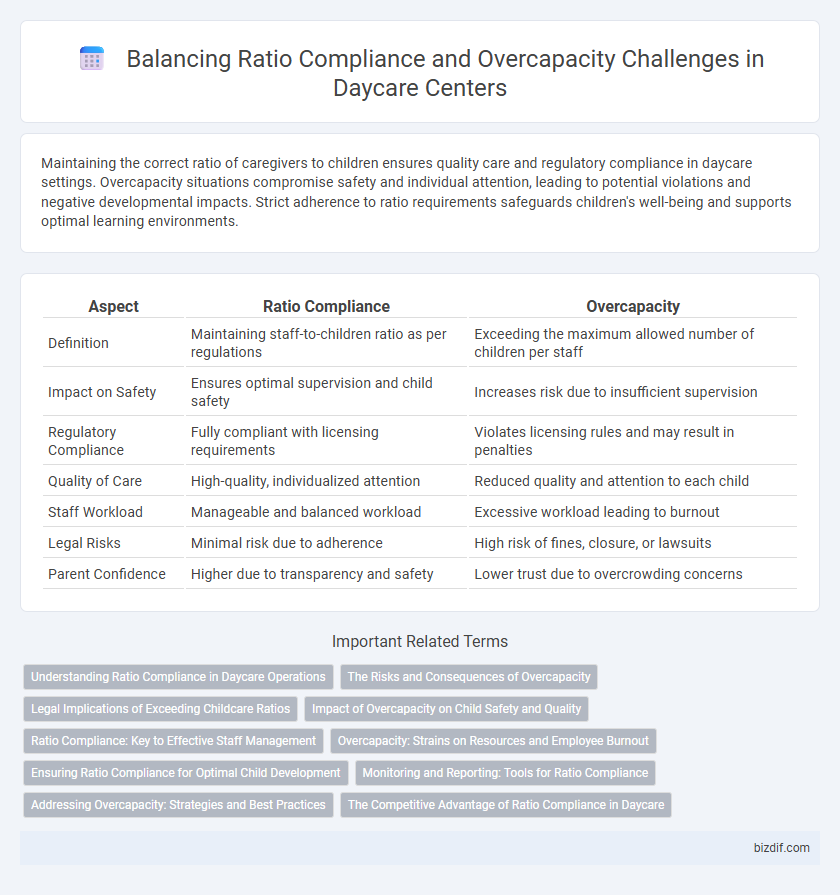Maintaining the correct ratio of caregivers to children ensures quality care and regulatory compliance in daycare settings. Overcapacity situations compromise safety and individual attention, leading to potential violations and negative developmental impacts. Strict adherence to ratio requirements safeguards children's well-being and supports optimal learning environments.
Table of Comparison
| Aspect | Ratio Compliance | Overcapacity |
|---|---|---|
| Definition | Maintaining staff-to-children ratio as per regulations | Exceeding the maximum allowed number of children per staff |
| Impact on Safety | Ensures optimal supervision and child safety | Increases risk due to insufficient supervision |
| Regulatory Compliance | Fully compliant with licensing requirements | Violates licensing rules and may result in penalties |
| Quality of Care | High-quality, individualized attention | Reduced quality and attention to each child |
| Staff Workload | Manageable and balanced workload | Excessive workload leading to burnout |
| Legal Risks | Minimal risk due to adherence | High risk of fines, closure, or lawsuits |
| Parent Confidence | Higher due to transparency and safety | Lower trust due to overcrowding concerns |
Understanding Ratio Compliance in Daycare Operations
Maintaining ratio compliance in daycare operations ensures each caregiver supervises an appropriate number of children, promoting safety and quality care. Overcapacity situations compromise this balance, increasing risks and potentially violating regulatory standards. Strict adherence to ratio requirements supports optimal child development and operational efficiency within licensed daycare facilities.
The Risks and Consequences of Overcapacity
Exceeding daycare ratio compliance significantly increases safety risks, including inadequate supervision and heightened chances of accidents or injuries among children. Overcapacity strains staff, leading to diminished attention per child and potential violations of licensing regulations, which can result in fines or facility closure. Maintaining proper staff-to-child ratios is essential for safeguarding child welfare and ensuring a quality caregiving environment.
Legal Implications of Exceeding Childcare Ratios
Exceeding childcare ratios in daycare settings violates licensing regulations and can result in legal penalties, including fines or suspension of the facility's license. Maintaining compliance with mandated child-to-staff ratios ensures child safety, reduces liability risks, and upholds state and federal childcare standards. Non-compliance may also lead to lawsuits if injuries occur, emphasizing the importance of strict adherence to ratio limits for legal protection.
Impact of Overcapacity on Child Safety and Quality
Overcapacity in daycare settings significantly compromises child safety by increasing the likelihood of accidents and reducing effective supervision. Exceeding mandated ratio compliance leads to overstretched caregivers, which diminishes responsiveness to individual children's needs and delays emergency interventions. Maintaining strict adherence to regulatory staff-to-child ratios is critical for ensuring optimal care quality and safeguarding children's well-being.
Ratio Compliance: Key to Effective Staff Management
Maintaining strict ratio compliance in daycare centers ensures each child receives adequate attention, directly influencing safety and developmental outcomes. Overcapacity situations compromise the mandated staff-to-child ratios, leading to increased risks and diminished quality of care. Effective staff management hinges on adhering to these ratios to balance workloads and promote a nurturing environment.
Overcapacity: Strains on Resources and Employee Burnout
Overcapacity in daycare centers severely strains available resources, leading to insufficient attention and care for each child. Exceeding ratio compliance often results in overcrowded classrooms, reduced safety standards, and limited access to educational materials. These pressures significantly increase employee burnout, causing higher turnover rates and negatively impacting the overall quality of childcare services.
Ensuring Ratio Compliance for Optimal Child Development
Maintaining strict ratio compliance in daycare settings is crucial for providing personalized attention and fostering optimal child development. Overcapacity situations can lead to reduced supervision, increased stress for caregivers, and diminished quality of care, negatively impacting children's social and cognitive growth. Adhering to regulated child-to-caregiver ratios supports safety, enhances learning experiences, and promotes healthy emotional development.
Monitoring and Reporting: Tools for Ratio Compliance
Effective ratio compliance in daycare settings relies on advanced monitoring and reporting tools that track child-to-staff ratios in real-time, ensuring adherence to state regulations. Digital platforms and automated systems facilitate accurate data collection, enabling administrators to identify overcapacity risks early and adjust staff allocation promptly. These technologies enhance transparency, support regulatory audits, and promote safer environments for children by maintaining optimal supervision levels.
Addressing Overcapacity: Strategies and Best Practices
Maintaining strict ratio compliance is essential for ensuring child safety and quality care in daycare settings, yet overcapacity remains a common challenge. Implementing strategic enrollment limits, optimizing staff scheduling, and utilizing real-time monitoring tools effectively address overcapacity by balancing child-to-staff ratios. Best practices include continuous staff training on regulatory requirements and leveraging technology to anticipate and manage fluctuating attendance, thereby minimizing risks associated with overcrowding.
The Competitive Advantage of Ratio Compliance in Daycare
Maintaining strict ratio compliance in daycare centers ensures optimal child-to-staff interaction, enhancing safety and personalized care, which fosters parental trust and satisfaction. Overcapacity situations often lead to diminished supervision quality and higher regulatory risks, potentially damaging reputation and leading to penalties. Daycares that prioritize ratio adherence gain a competitive advantage by promoting a safe, nurturing environment that attracts and retains families seeking quality early childhood education.
Ratio compliance vs Overcapacity Infographic

 bizdif.com
bizdif.com